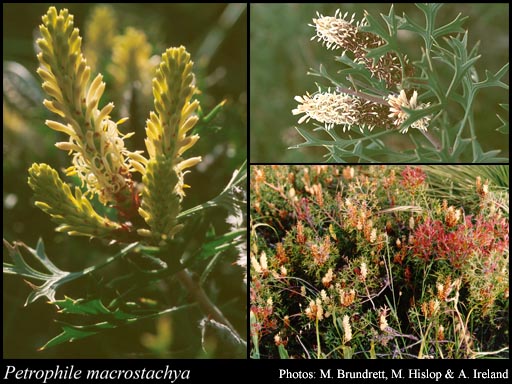- Reference
- Prodr. Suppl. 7 (1830)
- Conservation Code
- Not threatened
- Naturalised Status
- Native to Western Australia
- Name Status
- Current
Erect, compact or spreading, prickly shrub, 0.3-1.2 m high. Fl. yellow-cream, Jul to Nov. White, yellow/brown sand, gravel. Sandplains.

Scientific Description
Shrubs, 0.5-1 m high; branchlets hairy, with straight hairs. Leaves alternate, 30-80 mm long, glabrous; lamina flat, twice or more divided, pinnately divided, deeply divided, with (7-)9-17(-23) points or lobes; distance from base of leaf to lowest lobe 25-45 mm. Inflorescences not viscid, yellow. Perianth 7-9 mm long, glabrous; pistil 10-14 mm long; pollen presenter fusiform, hairy, 2-3.2 mm long. Cone with persistent scales, 20-25 mm long. Flowers in July, August, September, October or November. Occurs in the South-west (SW) Botanical Province(s), in the Geraldton Sandplains (GS), Swan Coastal Plain (SWA), Avon Wheatbelt (AW) or Jarrah Forest (JF) IBRA subregion(s).
Distribution
- IBRA Regions
- Avon Wheatbelt, Geraldton Sandplains, Jarrah Forest, Swan Coastal Plain.
- IBRA Subregions
- Dandaragan Plateau, Geraldton Hills, Katanning, Lesueur Sandplain, Merredin, Northern Jarrah Forest, Perth.
- Local Government Areas (LGAs)
- Armadale, Bayswater, Cambridge, Carnamah, Chapman Valley, Claremont, Coorow, Dandaragan, Gingin, Gosnells, Greater Geraldton, Irwin, Kalamunda, Nedlands, Northampton, Perth, Serpentine-Jarrahdale, Shark Bay, Stirling, Subiaco, Swan, Victoria Park, Victoria Plains, Wanneroo.